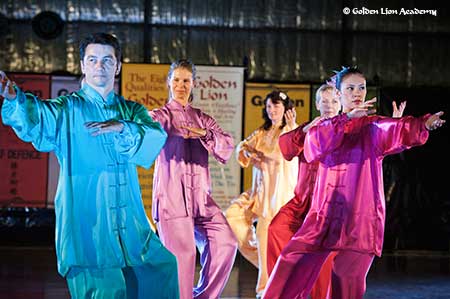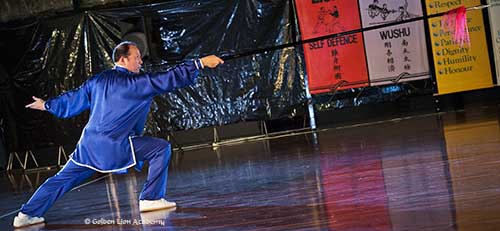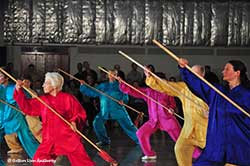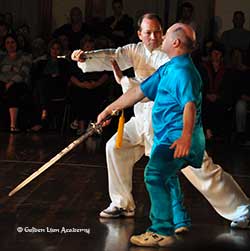Tai Chi – Dao Yin – Chi Kung forms and routines taught at the Golden Lion Academy consist of the following categories:
- Bare hands forms (single person and in groups)
- Weapons forms (single person and in groups)
- Two persons forms, for example:
— Two persons bare hands (such as push hands)
— Two persons weapon (such as bare hands versus a weapon)
— Two persons duelling weapons (such as two weapons against each other)
Please see below for details.
1. Bare Hands Tai Chi Forms

Beijing 24 Form Tai Chi Routine
This is the elementary tai chi routine that is part of the tai chi forms practised throughout the world. It is based on the Yang Style, which is characterised by rounded flowing movements.
This routine exhibits the smooth flowing nature of Yang style tai chi. It is constructed in a way that introduces the beginner to tai chi. Once the movements at the beginning have been learnt, it allows you to gently move on to more advanced techniques as you understanding and skills progress.
This Simplified Tai Chi (Taijiquan) 24 Form was created in 1956 by the National Physical Culture and Sports Commission of the People’s Republic of China. It is based on the Yang Family style of tai chi. Nowadays; this routine is considered the most suitable for beginners from adults to the elderly to start their enjoyment of Tai Chi.
It provides you with a solid introduction to the basic techniques of the Yang style of tai chi. When practised properly, the short form not only exemplifies grace and beauty but gives all the health benefits of tai chi practice such as improved balance to prevent falls, co-ordination, relaxation, natural strength and overall wellness. For these reasons, this Simplified 24 Taijiquan Form is widely taught at the Golden Lion Academy as a gentle mind and body exercise programme and has become very popular all over the world.
42 Forms International Combined Competition Tai Chi Routine
This is the standard international competition routine required for World Championships and Asian Games.
This routine is very popular for its diversity of styles adding a whole new experience to your Tai Chi.
The International Combined Tai ji quan Competition Routine in 42 Forms contains elements of the five major styles of Taijiquan: Chen Style, Yang Style, Wu Style, Wu Yuxiang Style and Sun Style.
Through learning the 42 Form with its representative movements from the major styles, students gain a greater appreciation of Tai Chi. Although different in style and form, all routines and forms require their practitioners to be tranquil, calm, relaxed, but mentally focused. In Tai Chi Chuan the spine is the pivot around which the body moves. Force and energy is generated from the spine and waist before reaching the legs and arms. The movements are executed slowly, continuously and softly, but firmness is implied in softness.
Under competition conditions, the International Combined Taijiquan Competition Routine is designed to last between 5 and 6 minutes in time.
48 Form International Combined Competition Routine
This Yang style form is also suitable for the advanced practitioner with some experience. It is a well-balanced and graceful form.
This routine is a favourite of many students because it takes a little longer and has its own rhythm and flow.
In the late 1970s all the main Tai Chi styles were combined to create this wonderful 48 bare hands Tai Chi routine. It is a true test to your staying power and focus. By breathing correctly and using the flow of the movements, your relaxed energy will see you through it. The growth in your flexibility, coordination, and balance can be a guaranteed success providing, of course, you practice this beautiful routine regularly.
Yang 40 Form
This is also a competition form for the Yang Style section of World International Championships and the Asian Games.
Students delight in this truly Yang style routine with its soft upright flowing nature.
By the late 1980’s with the rapid growth in popularity of Tai Chi there was an urgent need to develop competitive routines that focused on each of the four major styles of Tai Chi Chuan. The Chinese Wushu Association of China drew together leading professors and masters of each style to develop a competition routine for each style. In 1991 the Yang 40 competition routine was developed. It was based purely on the Yang Tai Chi style.
Sun 73 Form Tai Chi Routine (Taijiquan)
Initially students are generally a little apprehensive about starting a routine with 73 moves but quickly realise it is no more difficult than any of the other routines and find they really enjoy the “follow step” and “open and close hands” which are repeated many, many times.
This routine is one of the five Tai Chi Chuan competitions routine designed by the Chinese Wushu Association. The 73 Form Sun TC Routine was selected from the original Sun style, which encompass by small circular movements and high stances.
Dao Yin Chi Kung-YANG SHENG GONG BAO JIAN GONG
This is a combination of the principles of Chinese medicine and western medicine, Tai Chi, Chi Kung and ancient Chinese Health exercises dating from 3000 years ago.
This is truly a treasure from ancient China. Practiced regularly, it can restore and maintain good health.
The Dao Yin for General Health is a modern form of Qigong developed by Professor Zhang Guang of the Peoples Republic of China. The movements are designed to help you to be in a state of harmony, balance and calmness. The set of eight movements are designed for improving general fitness. The moves are easy to learn and remember because each move is repeated several times.
It provides a gradual approach to improvement in fitness and health in all the systems of the body. The main emphasis is on curing illness. Students start with the “Building and Moving Qi” routine and then progress to other routines. Click here for more on how you can do this Dao Yin exercise at home.
A workbook and DVD is available on the Building and Moving Qi routine. You can order your copy here, speak to your instructor or call us on 9796 1066.
2. Weapon Forms and Routines
 Sword 32 Form
Sword 32 Form
Practitioners worldwide now enjoy the tai chi Sword. This sword form was devised on the basis of the most popular set of Yang Style techniques and tai chi forms.
Sword play is a whole new experience, however with all the familiarity with barehand routines, students find adding a sword just adds a whole new dimension to their Tai Chi.
Tai Chi practitioners worldwide now enjoy the Tai Chi sword. This form was devised on the basis of the most popular set of Yang Style Tai Chi techniques. The 32 Form Sword is one of short weaponry routines and like the Beijing 24 in the bare hands routine it is an excellent way to learn the basic techniques of sword handling.
Sword 42 Form International Routine
This combined Sword routine is the international competition routine, required for World Championships and the Asian Games. Our International Tai Chi 42 Sword Form Work Book is available to you. This is the International Sword Competition Routine in 42 Forms. It contains elements of the five major styles of Taijiquan: Chen Style, Yang Style, Wu Style, Wu Yuxiang Style and Sun Style, all in one routine.
This routine further develops sword techniques. It is a vibrant and stylish routine that is exciting and very satisfying to learn.
Following the creation of the 42-Step International Combined Bare-hands Routine, the Chinese Martial Arts Research Institute organised a panel of experts to create a Tai Chi Sword International Competition Routine. This was completed in 1991 as 42 Form Tai Chi Jian Routine (Taijijian being the modern Pinyin way of writing the name of this routine). The 42 Form TC Jian Routine incorporates elements of Yang-style, Wu-style, Chen-style and other styles of taiji sword as well as Wudang Taiji Sword.
A leading member of this panel of experts was Professor Kan Gui Xiang of the Beijing University of Physical Education, one of China’s most respected Chen style teachers. Si Gung Charles Tsui-Po and Sifu Di Logan studied the 42-Step Taijijian Routine directly under Professor Kan shortly after it was first published.
Sifu Di took part in a demonstration event of this routine at the World Wushu Championships in Rome, 1997. Since then, a number of Golden Lion students have competed with this routine at both national and international levels, and achieved wide acclaim for their performances.
Fan: Yang 40 Form Routine (Tai Ji Shan)
At the start students find snapping the fan open and closed is challenging, but with practice drills, it takes no time for students to feel confident with it. This routine has a delightful flow punctuated with the sharp sound of the fan snapping.
This routine was designed by Master Cui Zhong San. Master Cui is the Fifth Generation Yang Style Master. Master Cui began Tai Chi Chuan training at the age of four under the discerning eye of his grandfather, Master Cui Yishi, a close, indoor disciple of Master Yang Chengfu. This routine is based on the Yang style. Si Gung Charles Tsui-Po studied the Yang 40 Fan Routine directly under Master Cui.
A fan might be used just for cooling oneself on a hot day or as a pretty souvenir to decorate a room but to the tai chi practitioner, it is a weapon with a multitude of potential applications as well as using the fan to perform a Tai Chi routine. Through learning the Yang 40 tai chi Fan routine, students enjoy the challenge of snapping the fan open while performing a routine that develops their strength, balance and coordination.

Spear: 16 and 26 Routine (Tai Ji Qiang)
The moment students see the spear they want to learn it! The 16 movement routine teaches the basic skills which are further developed in the 26 Form Spear Routine.
The tai chi spear with its metal tip, ring of red hair and long shaft is considered by many as the King of Weapons. The opportunity to learn this weapon is generally offered to students who have experience with shorter weapons like the sword, saber and fan because it requires skillful handling of such a long weapon.
The 16-movement form is a standardized Tai Chi spear routine, which was developed by a panel of experts including Master Men Huifeng in mainland China. It combines techniques from the major tai chi family styles. This routine introduces the students to the basic techniques, which are then developed further in the 26 Spear Routine. These two routines can be practiced individually or joined together to make a 42 form routine.
Saber: Yang 46 Form Tai Ji Dao Routine
After learning the two edged sword students find the sabre has a very different character that is well worth exploring. This routine is rarely seen and well worth the effort to learn.
This routine was also designed by Master Cui Zhong San. Master Cui is the Fifth Generation Yang Style Master. Master Cui began tai chi training at the age of four under the discerning eye of his grandfather, Master Cui Yishi, a close, indoor disciple of Master Yang Chengfu. This routine was also based on the Yang style.
As a weapon the sabre has a very long history and as a result the skillful handling of this weapon has been refined by masters over the centuries. The 46 Sabre contains the characteristic techniques of this single edged weapon along with the principles of the internal art of Tai Chi.
3. Two Persons Forms and Self Defence Applications

This is the martial arts side of tai chi. It involves learning and knowing how to use techniques for self-defence. It is suitable for the beginner to advanced level students.
There are also a few 2-man sets taught at the Golden Lion, they are reserved for advanced level pupils and instructors. The 2-man sets are:
- bare hands against bare hands
- bare hands against weapons
- weapon again same weapon
- weapon against different weapon
Call 9796-1066 today for a free trial class, or email us through our contact-us form.
More articles on Forms and Routines can be found in the Blog.
